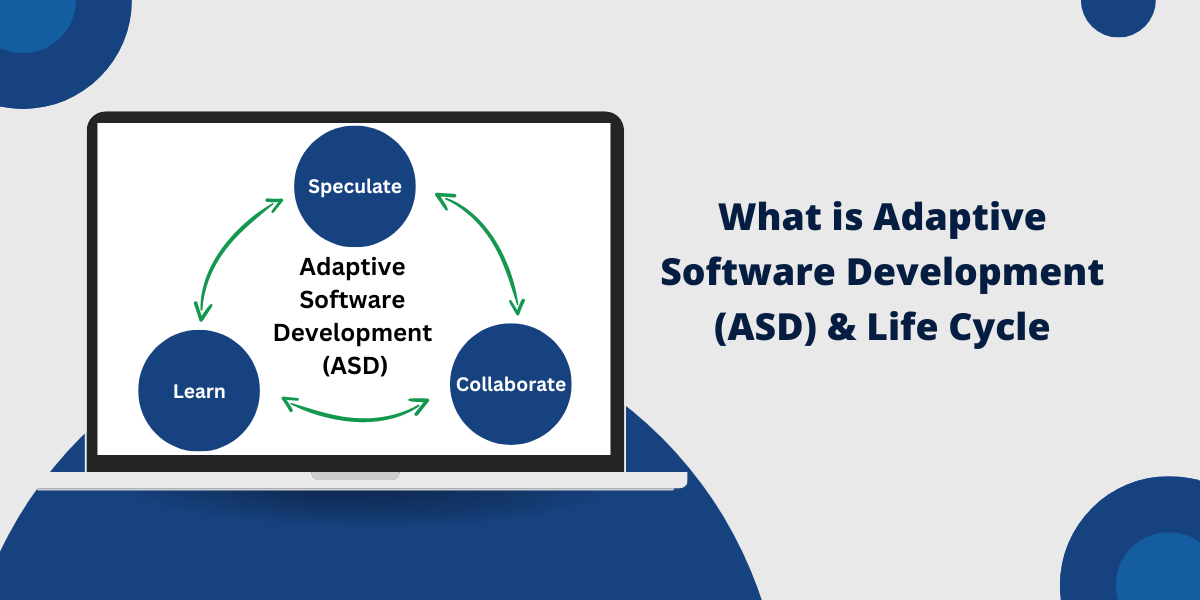Adaptive Software Development (ASD) Definition & Meaning
Adaptive Software Development (ASD) is an agile software development methodology designed to embrace changing requirements and ongoing collaboration between self-organizing teams.
First introduced by Jim Highsmith in the 1990s, ASD focuses on adapting quickly and efficiently to changes rather than following a rigid plan. This is achieved through techniques like iterative development, frequent testing, and continuous integration of feedback from users and stakeholders.
Some Key Principles of ASD
- Incremental planning and prioritization
- Component-based architectures
- Early prototyping
- Continuous integration and testing
- Embracing changing requirements
- Fostering collaboration between teams
Rather than creating extensive upfront plans, ASD teams collaborate closely with stakeholders, build and deliver software iteratively, obtain feedback frequently, and use this to guide the next iterations.
ASD provides a framework for developing complex, innovative software products adaptively in dynamic, rapidly changing environments. It is especially useful for innovative software projects with rapidly evolving requirements.
Let’s look at the key aspects of Adaptive Software Development methodology in more detail:
Key Takeaways
- Adaptive Software Development (ASD) is an agile software development methodology that embraces changing requirements and collaboration between self-organizing teams.
- ASD focuses on adapting quickly and efficiently to changes through iterative development, frequent testing, and feedback incorporation.
- Key principles of ASD include incremental planning, component-based architectures, early prototyping, and continuous integration and testing.
- ASD teams are organized into three groups: Core Team, Development Team, and Virtual Team. Roles are flexible and interchangeable.
- ASD follows a “speculate, collaborate, learn” cycle rather than a rigid plan-driven approach. Requirements evolve through collaboration and testing.
- The benefits of ASD include improved adaptability, faster time to market, higher quality products, better stakeholder collaboration, and the ability to manage changing priorities.
- Challenges include dependence on customer involvement, potential scope creep, and overhead from continuous integration and testing. Proper implementation is key.
How ASD Teams Are Organized
ASD teams are organized into three main groups:
Core Team
- Led by the project manager
- Includes key developers, testers, architects, key stakeholders
- Manage high-level requirements, priorities, risks
Development Team
- Includes developers, testers
- Build, integrate, test, and deliver working software increments
- Typically 5-8 members
Virtual Team
- Subject matter experts, specialists, customer reps
- Provide input whenever needed to develop teams
- Flexible, dynamic collaboration
The roles between these teams are flexible and interchangeable. For example, developers may collaborate closely with stakeholders to refine requirements rather than just working in isolation.
The adaptive, collaborative team structure is a core element of ASD.
ASD Life Cycle and Process
Rather than following a sequential, plan-driven approach, ASD follows an iterative “speculate, collaborate, learn” cycle:
Speculate
- Identify the initial project vision, basic features, and rough plan
- Form core team, conduct initial planning workshop
- Develop prototype, create component architecture
Collaborate
- Engage virtual team and stakeholders for feedback
- Refine requirements and priorities, plan through collaboration
- Develop incremental software releases with iterative cycles
Learning
- Test software, obtain user feedback
- Incorporate learnings, refine architecture
- Adapt plan for next increment, adjusting to change
This cycle repeats, with the software evolving through continuous feedback and learning.
There are no fixed phases—the process is dynamic to handle changing needs. Frequent collaboration and testing enable adapting to change and emergent requirements.
Key ASD Practices
Some key practices used in ASD include:
- Incremental Planning: An initial high-level plan is developed. Based on feedback, detailed planning happens iteratively for each increment.
- Component-Based Architectures: Systems are built from modular, plug-and-play components that can be easily changed.
- Continuous Integration and Testing: New code is integrated, and builds are tested multiple times a day to enable rapid feedback.
- Regular Stakeholder Reviews: Stakeholders are actively engaged to get regular feedback on priorities and changing needs.
- Iterative Development: Rather than big bang releases, the software is built in small, rapid cycles focused on the highest priorities.
- Prototyping: Quick prototypes are built early on to validate ideas and architecture before full development.
- Embracing Change: Requirements evolve based on user feedback, and the scope is flexible to adapt to changing business needs.
ASD Team Roles
While roles are flexible in ASD, some typical roles include:
- Project Manager: Leads planning, coordinates teams, manages risks and timelines
- Architect: Defines overall architecture and components, ensures technical integrity
- Developers: Build, integrate, and unit test code components iteratively
- Testers: Develop test cases, perform integration and system testing
- Customer Representatives: Provide ongoing feedback and priorities from a user perspective
- Subject Matter Experts: Provide domain knowledge and specialized expertise
ASD Artifacts
Some key artifacts produced in ASD include:
- Project Vision Document: High-level overview of goals, scope, and priorities
- Release Plan: Iterative plan for delivering incremental functionality
- Iteration Plan: Detailed plans for each development iteration
- Prototypes: Proofs of concept to validate architecture and design
- User Stories: User requirements for specific functionality
- Product Backlog: Prioritized list of required features and fixes
- Working Software: The incrementally built and tested software
- Bug/Issue Tracking: Using tools like JIRA to track issues and bugs
- Retrospectives: Review of what worked and lessons learned after each iteration
Why Use the ASD Methodology?
Some key benefits of using Adaptive Software Development include:
- Adaptive to Change: By embracing change, ASD enables adapting to changing user needs and priorities.
- Early Value Delivery: Incremental releases allow for faster and earlier delivery of value.
- Higher Quality: Continuous testing and feedback improve software quality.
- Risk Reduction: Progressive elaboration of requirements reduces risk and uncertainty.
- Collaboration: Development teams collaborate closely with stakeholders for better solutions.
- Morale: ASD provides a motivating work environment with less rigid processes.
- Scalability: Component architectures enable greater reusability and scalability.
What are the Challenges and Considerations for ASD
Some potential challenges to keep in mind with ASD include:
- Customer Commitment: Require significant access to real end users for feedback.
- Scope Creep: Scope may expand uncontrollably without proper prioritization.
- Skills Required: Team members must be skilled in agile, iterative development.
- Overheads: Continuous integration and testing require infrastructure.
- Undefined Requirements: Requirements must evolve pragmatically from prototypes.
- Architecture Complexity: Component-based architecture requires upfront investment.
- Team Coordination: Self-organizing teams require coordination.
Best Practices for Implementing ASD
Some best practices for successfully implementing ASD include:
- Obtain strong management support and establish a culture accepting of change.
- Start with stabilizing and streamlining engineering processes.
- Build an adaptive, modular architecture focused on high-change areas.
- Form a strong, committed core team to drive the process.
- Develop working software in short 1-3 week iterations.
- Leverage prototyping to experiment and evolve requirements.
- Establish close stakeholder collaboration with easy feedback channels.
- Maintain focus on highest priority features and bug fixes.
- Employ continuous integration and automated testing.
- Hold regular retrospectives and adapt processes as needed.
- Provide relevant training in agile practices for team members.
ASD vs Other Agile Methodologies
ASD shares many common concepts with other agile methods like Scrum and XP but has some distinct differences:
Scrum
- Both iterative and incremental.
- Scrum prescribes specific roles and rituals like daily standups. ASD has flexible roles.
- Scrum focuses more on project management. ASD on adaptable engineering techniques.
Extreme Programming (XP)
- Both focus on engineering best practices like testing and continuous integration.
- XP prescribes more specific engineering practices. ASD does not.
- ASD focuses more on adaptive planning and specifications.
Feature Driven Development (FDD)
- Both adapt planning and development to changing needs.
- FDD focuses on the detailed modeling of features. ASD focuses on high-level capabilities.
- ASD embraces changing requirements more fully.
Final Words
Adaptive Software Development provides a lightweight, flexible approach to building innovative software products in rapidly changing environments.
By focusing on adaptable engineering techniques, incremental delivery, stakeholder collaboration, and embracing changing requirements, ASD enables continuous alignment of development efforts with customer needs and priorities.
ASD works best for complex domains with unclear requirements upfront. It requires an organizational culture and strong team capability to thrive with uncertainty. With proper implementation, ASD can deliver faster time-to-market and higher quality compared to traditional plan-driven approaches.
In summary, Adaptive Software Development is an effective methodology for organizations looking to deliver customer value quickly and continuously in dynamic business environments.
Frequently Asked Questions (FAQs)
Here are some common FAQs about Adaptive Software Development:
Does ASD eliminate planning?
No. ASD allows high-level planning upfront but leaves details to emerge iteratively based on learnings. Some initial vision and scoping are still required.
How large should an ASD team be?
Optimal ASD teams are small, with the development team ranging from 5 to 8 members. Large teams are broken into smaller agile teams.
How long are iterations in ASD?
ASD iterations can range from 1 to 3 weeks, enough to develop and test a small increment of customer value. Longer cycles reduce feedback and adaptability.
Does ASD require extensive documentation and artifacts?
No. ASD focuses on working software rather than detailed documentation. Just enough artifacts are created to support development and coordination.
How is scope managed in ASD without upfront requirements?
The scope is aligned with priorities and the emergence of critical features. Constant stakeholder interaction and prototyping guide pragmatic scope management.
When is ASD not suitable for a project?
ASD may not work well for mature domains where requirements are clear upfront. It requires customer access and comfort with fluid requirements.
How is team productivity measured in ASD?
ASD focuses less on individual productivity and more on overall customer value delivered by the team. Progress is measured through working software.
Does ASD require special tools or infrastructure?
ASD can work with minimal tools. However, continuous integration and test automation tools help maximize its effectiveness.

Priya Mervana
 Verified Web Security Experts
Verified Web Security Experts
Priya Mervana is working at SSLInsights.com as a web security expert with over 10 years of experience writing about encryption, SSL certificates, and online privacy. She aims to make complex security topics easily understandable for everyday internet users.



